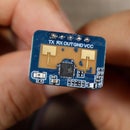Introduction: Air Quality Monitor With SDS011 Sensor
My town has a really bad air pollution issue in winter so I made a sensor to better monitor the situation as part of the pulse.eco platform.
The device uses the SDS011 particle sensor as well as a BME680 sensor to monitor PM2.5 and PM10 particles and temperature, humidity and air pressure.
Supplies
By buying through the links below, you support the channel at no extra cost for you!
- NodeMCU - https://s.click.aliexpress.com/e/_m0s6Uu6
- Nova PM Sensor SDS011 - https://s.click.aliexpress.com/e/_DFO7AAL
- BME680 Temperature, Humidity, and Pressure Sensor - https://s.click.aliexpress.com/e/_Dk9ePkx
- LM386 Sound Sensor - https://s.click.aliexpress.com/e/_DdoWDXt
- Jumper Wires - https://s.click.aliexpress.com/e/_DkWW1nZ
- Soldering Station - https://s.click.aliexpress.com/e/_DkA1M2L
- Electrical Box - https://s.click.aliexpress.com/e/_Dd1I0h1
- Wire Snips - https://s.click.aliexpress.com/e/_DFP86vv
- Assorted Resistors - https://s.click.aliexpress.com/e/_DEGPslp
- Hot Glue Applicator - https://s.click.aliexpress.com/e/_DBqcu4B
- Prototyping PCBs - https://s.click.aliexpress.com/e/_DcvrbuF
Step 1: Connect the Components
The sensor can be constructed in many ways and I choose to use one of my Prototyping PCBs to solder everything to it. The BME680 sensor is connected to 3.3V, GND and pins D1 and D2, while the SDS011 sensor is connected to the Vin pin for powering it with 5V, GND and pins D5 and D6.
The sound sensor is powered from 3.3V and it is connected with its analog output to pin A0 of the NodeMCU board.
Please use the attached image for the exact connections.
Step 2: Flash the Firmware
The firmware is provided by the pulse.eco platform and it can be found on their official construction page at: https://pulse.eco/constructWiFi
The flashing procedure is done with NodeMUC PyFlasher and it only lasts a minute or so.
Step 3: Set Your Device Details
Once the device is flashed, it will create its own WiFi network that you will need to connect to and open up 192.168.1.1 in your browser so you can set the required parameters for the device id and your WiFi details.
Step 4: Package It Inside an Enclosure
Once the device is ready, it needs to be packaged in an enclosure so it can be then mounted outside.
There is an official #D printable enclosure so if you own a 3D printer then you can enclose it in it but since I don't, I used an electrical box to place everything inside.
Step 5: Take Action!
With the sensor ready and the data publically available, we hope that we can pressure the authorities to take action to prevent the issue of air pollution from happening. In the meantime, I plan to use the data to create actions and notifications in my home automation setup so if that is something that sparks your interest, follow me here on Instructables and subscribe to my YouTube channel.




